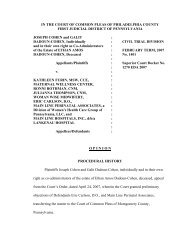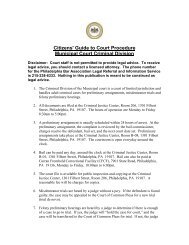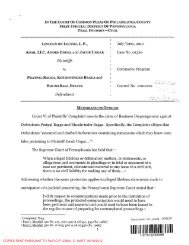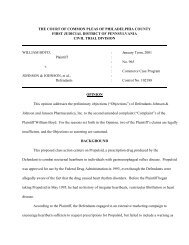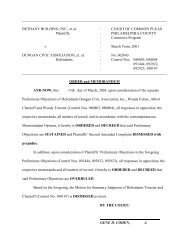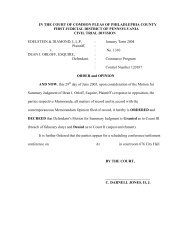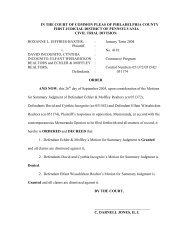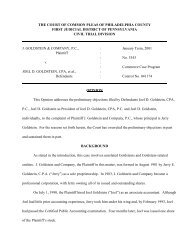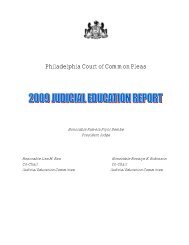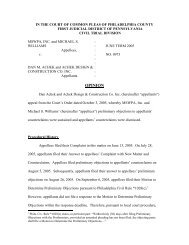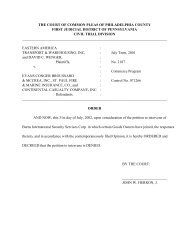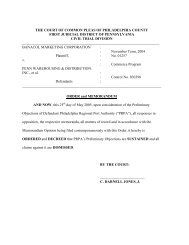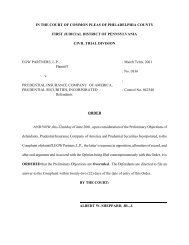BARRY SANDROW d/b/a BARRY SANDROW REAL ESTATE vs ...
BARRY SANDROW d/b/a BARRY SANDROW REAL ESTATE vs ...
BARRY SANDROW d/b/a BARRY SANDROW REAL ESTATE vs ...
Create successful ePaper yourself
Turn your PDF publications into a flip-book with our unique Google optimized e-Paper software.
IN THE COURT OF COMMON PLEAS<br />
OF THE FIRST JUDICIAL DISTRICT OF PENNSYLVANIA<br />
CIVIL TRIAL DIVISION<br />
<strong>BARRY</strong> <strong>SANDROW</strong> d/b/a :<br />
<strong>BARRY</strong> <strong>SANDROW</strong> <strong>REAL</strong> <strong>ESTATE</strong> : JULY 2000<br />
: NO. 3933<br />
v. :<br />
: COMMERCE PROGRAM<br />
RED BANDANA, CO. d/b/a :<br />
ED LONDON WREATH COMPANY :<br />
INTRODUCTION<br />
O P I N I O N<br />
Plaintiff Barry Sandrow, doing business as Barry Sandrow Real Estate (“Sandrow”), seeks a new<br />
trial because he asserts that this court improperly granted a nonsuit based on a letter agreement dated<br />
January 2, 2000 between plaintiff and defendant Red Bandana. He also requests the entry of judgment in<br />
1<br />
his favor in the amount of $66,328.75. For the reasons set forth below, this court denies plaintiff’s motion<br />
for a new trial because the January 2, 2000 letter agreement at issue released Red Badana from any<br />
additional rental payments to Sandrow.<br />
I. STATEMENT OF FACTS<br />
The Parties<br />
1. Plaintiff Barry Sandrow, d/b/a Barry Sandrow Real Estate, was the owner of property (“property”)<br />
located at 1500 East Erie Avenue in Philadelphia throughout the relevant period. N.T. from 1/16/2002<br />
1. See Plaintiff’s Motion, 38 (requesting judgment of $66,323.75). In his Memorandum of Law,<br />
however, plaintiff seeks entry of a judgment in the amount of $69,079.42. See Plaintiff’s Memorandum<br />
at 15.<br />
1
Hearing (“hereinafter N.T.”) at 17.<br />
2. Defendant Red Bandana, d/b/a Ed London Wreath Company, became a tenant of this property<br />
after entering into a lease dated October 1, 1994 (the “October 1994 Lease”). N.T. 19 & P.-1. The lease<br />
was signed by Janet Barag, President of Red Bandana. N.T. at 56, P.-1, & P.-6.<br />
3. Nathan Zinberg was the building manager for the property for the period between October 1994<br />
until October 1998. He procured Red Bandana as a tenant. N.T. at 18, 44.<br />
The Lease<br />
4. The October 1994 lease was for a five year term from October 1, 1994 until the last day of<br />
September 1999. It provided for an initial minimum monthly rent of $1,410 with increments for each year,<br />
reaching a monthly rent of $1,735 for the fifth year. P.-1<br />
5. A typed-in clause to the form lease provides that “Rent shall include heat, electric, water/sewer and<br />
all taxes.” P.-1, October 1994 Lease, 4(b).<br />
6. The lease also provided under “additional rent” for the payment of taxes by the tenant:<br />
Lessee further agrees to pay as rent in addition to the minimum rental herein reserved all<br />
taxes assessed or imposed upon the demised premises and/or building of which the<br />
demised premises is a part during the term of this lease, in excess of and over and above<br />
those assessed or imposed at the time of making this lease. The amount due hereunder on<br />
account of such taxes shall be apportioned for that part of the first and last calendar years<br />
covered by the term hereof. The same shall be paid by Lessee to Lessor on or before the<br />
first day of July of each and every year. P.-1, October 1994 Lease 6(b).<br />
7. Although the lease was for first floor warehouse space of approximately 7500 square feet, it<br />
provided for an extension “to upper floor, so if Tenant rents any footage, rate shall be $l.60 per sq. ft.<br />
complete, increased 5 % per year.” P.-1, October 1994 Lease, 4(e).<br />
2
8. The lease also provided that the tenant had the right to use the upstairs space “anytime work is<br />
being done downstairs.” P.-1, October 1994 Lease, 34.<br />
The Condition of the Property and the Resulting “Swap Agreement”<br />
9. Ms. Barag testified that “from the very beginning we had continual water problems. Continual.<br />
Rooms were flooded.” N.T. at 58. About three years into the lease, part of the downstairs area of the<br />
premises became unusable due to leaks into the area the tenants referred to as the “waterfall room”. N.T.<br />
at 60.<br />
10. When informed of this problem, Nathan Zinberg approached Barry Sandrow for his consent to<br />
allow the tenants to use part of the upstairs for storage. N.T. at 20. It was Zinberg’s understanding that<br />
the tenants would occupy an area in the upstairs directly proportional to the area from which they were<br />
displaced in the downstairs area. N.T. at 45-46.<br />
11. Barry Sandrow acknowledged that Zinberg had told him that the building had a water problem.<br />
N.T. at 20. Sandrow testified that he agreed to allow the tenants to use “whatever space that they had<br />
to replace” as a “swap.” N.T. 20. He stated that this arrangement seemed to work although he did not<br />
have direct contact with Red Bandana until 1998 when Zinberg was terminated as building manager. N.T.<br />
21-24.<br />
December 1998 Agreement<br />
12. Sandrow testified that after taking control of the management of the building, he subsequently<br />
discovered in October 1998 that Red Bandana was using “quite a bit of space” upstairs which he estimated<br />
as 80% of the space or approximately 23,000 square feet. N.T. at 23-24.<br />
13. Upon discovering that Red Bandana was using this additional space in the upstairs area, Sandrow<br />
consulted with Janet Barag who offered to pay $500 in additional rent. Sandrow testified that he accepted<br />
3
this offer. N.T. at 25.<br />
14. Sandrow testified that this agreement by Red Bandana to pay additional rent for the upstairs space<br />
for the period between November 1998 and October 1999 was accurately reflected in a letter dated<br />
12/1/98 (“December 1998 Agreement”) that was signed by Barag as President of Red Bandana. N.T. at<br />
26, P.-2<br />
.<br />
15. The December 1998 agreement provides:<br />
This shall serve as an agreement to pay $500.00 per month for the use of approximately<br />
5000 sq. ft. of space on the upper floor of 1500 E.Erie Ave. Commencing on November<br />
1st 1998 and running concurrent with the terms of the original lease dated October 1,<br />
1994. P.-2.<br />
Use and Property Tax Assessment<br />
16. Sandrow testified that he received a notice from the Department of Revenue from the City of<br />
Philadelphia stating that he owed unpaid Use and Occupancy taxes for the period between 1995 through<br />
April 1998 on the Erie Avenue property of $9,361. N.T. at 28, P.-3. He testified that he appealed this<br />
assessment and the amount due was reduced to “$6,600 or something like that.” N.T. at 29.<br />
17. Sandrow stated that he showed this tax bill to Janet Barag. He testified that she stated that she had<br />
paid a deposit of $1,500 to Zinberg, and “that she would pay the bill if I would take that 1500 dollars off<br />
the bill.” N.T. at 30.<br />
18. Janet Barag testified to a recollection of this Use and Property Tax Assessment. She stated that<br />
Sandrow had brought this to her attention when discussing that “[h]e had a lot of financial problems.” N.T.<br />
at 65. When asked whether she agreed to pay that tax bill, she stated:<br />
We agreed to make a settlement at the end. This is after we had vacated the building, that we<br />
would make a settlement. We just wanted to go forward with our business. N.T. at 65.<br />
January 2, 2000 Letter<br />
4
19. Sandrow testified that “about the time” that Red Bandana vacated the premises, a handwritten<br />
letter agreement dated January 2, 2000 on the letterhead of “Ed London Wreath Company” was drafted.<br />
N.T. at 34. That letter provides:<br />
Payment of the enclosed check for $6635.47 minus $1500 security deposit = $5135.47. This<br />
represents payment in full for all taxes, expenses and charges both past and future pertaining to<br />
1500 E. Erie Ave. The exception being our portion of gas, electric and cleaning for 10-1-99 thru<br />
12-31-99.<br />
The intent of this agreement is understood.<br />
This agreement corresponds to the terms of the lease from 10-94 to 10-99.<br />
Janet Barag Pres. Red Bandana Co.<br />
1/4/00<br />
B Sandrow Real Estate<br />
P.-6.<br />
20. In his initial testimony about this letter, Sandrow was asked “was it your understanding that this<br />
letter released Red Bandana from paying any additional rents to you as a result of their use of additional<br />
space.” He responded: “Yes. Except the fact that this sentence here, this agreement corresponds to the<br />
terms of the lease from 10/94 to 10/99. I don’t remember that being on this letter.” N.T. at 32.<br />
21. Sandrow subsequently testified that the letter was intended to release the tenants just from the tax<br />
payments. N.T. at 33.<br />
22. Barag testified that her understanding was that the January 2, 2000 letter “was a total release.<br />
This was the letter that was basically severing our ties.” N.T. at 66. She stated that she wrote the letter but<br />
that Sandrow had asked her to add the last line that this agreement corresponds to the terms of the lease.<br />
N.T. at 67.<br />
Removal of the Heaters<br />
23. After Red Bandana vacated the property, Sandrow discovered that some heaters had been<br />
removed and that the sprinkler system and pipes had frozen. N.T. at 34.<br />
5
24. Barag admitted that Red Bandana had removed three heaters which she claimed they owned. N.T.<br />
at 68. She stated that the heaters had been suspended from the ceiling. N.T. at 78. No heaters, however,<br />
had been placed in the loading docking area. N.T. at 83. Zinberg, likewise, testified that the loading dock<br />
area had been unheated. N.T. at 90<br />
25. Barag testified that when confronted by Sandrow about the missing heaters she agreed to return<br />
the heaters and hired a “heating guy” to replace them. N.T. at 68-69. She conceded that under the terms<br />
of the lease, any alterations or equipment installed at the property by Red Bandana had to remain at the<br />
property. N.T. at 85-86.<br />
26. Sandrow stated that he called repairmen for the sprinkler system and had temporary heating placed<br />
in the area. N.T. at 35.<br />
27. He presented invoices for the sprinkler repairs totaling $2,400, (P.-8), an invoice of $428 for<br />
installation of temporary heating for the loading dock area (p.-7) and an invoice of $376 (P.-9) for<br />
replacement of thermostats. N.T. at 35-37.<br />
28. After plaintiff presented his case, defendant presented a motion for a nonsuit. The Court granted<br />
the nonsuit as to plaintiff’s demand for additional rent. The nonsuit was denied, however, as to the damages<br />
sought by plaintiff for removal of the heaters, and the resulting water and ice damage. N.T. at 74.<br />
29 Based on testimony and evidence presented as to the damages caused by defendant’s removal of<br />
the heaters, the Court found in favor of the plaintiff in the amount of $2,776 as a result of damages incurred<br />
due to the removal of the heater based on invoices P.-8 and P-.9. N.T. at 104.<br />
30. The claim for $428 (P.-7) was excluded because it referenced heater installation in the loading<br />
dock area while testimony did not support that there had previously been any heat in that area. N.T. at<br />
104-05.<br />
6
DISCUSSION<br />
Plaintiff has filed a motion for post trial relief seeking, inter alia, a new trial. He argues that it was<br />
error to grant defendant’s motion for a nonsuit based on this court’s conclusion that the January 2, 2000<br />
letter constituted a release of all claims for rent due by plaintiff. Plaintiff also seeks the entry of a judgment<br />
of $66,328 in his favor based on plaintiff’s testimony that the Philadelphia Tax Review Board had found<br />
that defendant utilized one-third of the usable space at the property throughout the lease term. 2<br />
The standards for ordering a new trial are well established. A motion for a new trial should be<br />
granted if the “trial court committed an error of law which controlled the outcome of the case or committed<br />
an abuse in discretion.” Cangemi v. Cone, 774 A.2d 1262, 1265 (Pa. Super. 2001). An order denying<br />
a new trial will be reversed if the trial court “clearly and palpably abused it discretion or committed an<br />
error of law which affected the outcome of the case.” Brinich v. Jencka, 2000 Pa. Super. 209, 757 A.2d<br />
388, 395 (2000), app. denied, 565 Pa. 634, 771 A.2d 1276 (Pa. 2001), quoting Whyte v. Robinson, 421<br />
Pa. Super. 33, 617 A.2d 380 (1992).<br />
A key issue raised in plaintiff’s motion is whether a nonsuit was properly entered as to his claim for<br />
additional rent. A nonsuit may be entered “only in clear cases.” Friedman v. Schoolman, 483 Pa. 614,<br />
634, 398 A.2d 615, 625 (1979). In determining whether to enter a nonsuit, the plaintiff must be given “the<br />
2. See Plaintiff’s Motion for a New Trial, 28-38.<br />
7
enefit of every fact and reasonable inference arising from the evidence.” Berman Properties, Inc. v.<br />
Delaware County Bd. of Assessment and Appeals, 658 A.2d 492, 494 (Pa. Cmwlth. 1995). The<br />
Pennsylvania Superior Court recently outlined the general standards for entering a nonsuit:<br />
A motion for compulsory non-suit allows a defendant to test the sufficiency of a plaintiffs’ (sic)<br />
evidence and may be entered only in cases where it is clear that the plaintiff has not established a<br />
cause of action; in making this determination, the plaintiff must be given the benefit of all reasonable<br />
inferences arising from the evidence. When so viewed, a non-suit is properly entered if the plaintiff<br />
has not introduced sufficient evidence to establish the necessary elements to maintain a cause of<br />
action; it is the duty of the trial court to make this determination prior to the submission of the case<br />
to the jury. Hong v. Pelagatti, 765 A.2d 1117, 1121 (Pa. Super. 2001)(citations omitted).<br />
Plaintiff Sandrow contends that a nonsuit should not have been entered in this case because the<br />
letter dated January 2, 2000 did not constitute a release of all of plaintiff’s claims for rent due from the<br />
3<br />
defendant Red Bandana. Plaintiff is correct that a release must be strictly construed “so as to discharge<br />
only those rights intended to be relinquished.” Vaughn v. Didizian, 436 Pa. Super. 436, 439, 648 A.2d 38,<br />
40 (1994). A release, like a contract, should be construed to determine the intention of the parties. Brown<br />
v. Cooke, 707 A.2d 231, 232 (Pa. Super. 1998), quoting Flatley v. Penman, 429 Pa. Super. 517, 632<br />
A.2d 1342 (1993).<br />
The scope of a release “must be determined from the ordinary meaning of its language” and where<br />
releases “involve clear and unambiguous terms, the court need only examine the writing itself to give effect<br />
to the parties’ understanding.” Seasor v. Covington, 447 Pa. Super. 543, 547, 670 A.2d 157, 159 (1996).<br />
It may also be necessary, however, to go beyond the ordinary words of the release. In Vaughn v.<br />
Didizian, for instance, the Superior Court held that the trial court erred in failing to interpret a general<br />
3. See Plaintiff’s Motion for New Trial, 3, 6, 9, 22.<br />
8
elease “in light of the conditions and circumstances surrounding its execution.” Vaughn v. Didizian, 436<br />
Pa. Super. 436, 437, 648 A.2d 38, 39 (1994). The Vaughn court thus concluded:<br />
In construing this general release, a court cannot merely read the instrument. Instead, it is crucial<br />
that a court interpret a release so as to discharge only those rights intended to be relinquished. The<br />
intent of the parties must be sought from a reading of the entire instrument, as well as from the<br />
surrounding conditions and circumstances. Thus, the trial court erred in failing to construe the<br />
language of this general release in light of the conditions and circumstances surrounding its<br />
execution. Vaughn v. Didizian, 436 Pa. Super. at 439, 648 A.2d at 40.<br />
Consequently, “ a release ordinarily covers only such matters as can fairly be said to have been within the<br />
contemplation of the parties when the release was given.” Estate of Bodnar, 472 Pa. 383, 387, 372 A.2d<br />
746, 748 (1977).<br />
The January 2, 2000 letter agreement that is at the center of the parties’ dispute was handwritten<br />
on the plaintiff’s letterhead (Ed London Wreath Company). It provides:<br />
1/2/2000<br />
Payment of the enclosed check for $6635.47 minus $1500.00 security deposit = $5135.47. This<br />
represents payment in full for all the taxes, expenses and charges both past and future pertaining<br />
to 1500 E. Erie Ave. The exception being our portion of gas, electric and cleaning for 10-1-99 thru<br />
12-31-99.<br />
The intent of this agreement is understood.<br />
The agreement corresponds to the terms of the lease from 10-94 to 10-99.<br />
Janet Barag, Pres. Red Bandana<br />
1/4/00<br />
B. Sandrow Real Estate<br />
P.-6.<br />
The “ordinary language” of this agreement thus states that $6635.47 minus a security deposit of<br />
$1500 “represents payment in full for all the taxes, expenses and charges both past and future pertaining<br />
to 1500 E.Erie Ave.” P.-6 (emphasis added). The agreement also explicitly excludes the following three<br />
items or services from this release: “gas, electric and cleaning.” The agreement finally provides that it<br />
9
corresponds to the lease in existence from October 1994 to October, 1999. Id.<br />
The check tendered under this agreement thus constituted payment in full “for all taxes, expenses<br />
and charges” “pertaining to 1500 E. Erie Ave.” The explicit exclusions applied unambiguously and<br />
narrowly only to “gas, electric and cleaning.” Rent clearly was not excluded from this agreement.<br />
Logically, therefore, rent is encompassed within the agreement’s reference to all “expenses or charges.”<br />
This conclusion is buttressed by the January 2, 2000 agreement’s reference to the October 1994 lease.<br />
The January 2, 2000 Agreement specifically provides that it “corresponds to the terms of the lease<br />
from 10-94 to 10-99.” P.-6. That lease stated that “Rent shall include heat, electric, water/sewer and all<br />
taxes.” P.-1, para. 4(b). Under the lease, therefore, rent was an inclusive term. Reading these two<br />
documents together as required by the January 2, 2000 agreement underscores that under the typed in<br />
provisions to the October 1994 lease, rent was broadly defined as including such expenses as “heat,<br />
electric, water/sewer and all taxes.” The subsequent January 2, 2000 agreement thus encompasses the<br />
rent, taxes and other expenses set forth in the October 1994 lease while explicitly excluding the “electric”<br />
that had been included as rent under the October 1994 lease.<br />
Interpreting these ordinary words within the surrounding circumstances and conditions supports<br />
this conclusion that the January 2, 2000 letter agreement included all rents due at the time the agreement<br />
was executed. Barry Sandrow testified that this agreement had been drafted “about” the time Red Bandana<br />
vacated the premises. Finding of Fact 19; N.T. at 33-34. Ms. Barag was more explicit in timing the drafting<br />
of the January 2, 2000 letter:<br />
We agreed to make a settlement at the end. This is after we had vacated the building, that we<br />
would make a settlement. We just wanted to go forward with our business. It was a very rough<br />
experience being in that building. We wanted to basically wash our hands and go forward. N.T.<br />
10
at 65.<br />
Ms. Barag stated that she wrote most of the letter but that Barry had suggested adding the last<br />
sentence that this agreement corresponds with the terms of the lease. N.T. at 67. Mr. Sandrow, however,<br />
had no recollection of that sentence. N.T. at 32. The practical point, however, is that both parties agree<br />
that the letter was drafted at the end of their relationship and at a point when Red Bandana had either<br />
vacated the premises or was close to doing so. This supports an interpretation of the January 2, 2000<br />
agreement as a comprehensive, global settlement, or, as Ms. Barag testified, “[t]his was the letter that was<br />
basically severing our ties.” N.T. at 66.<br />
It must be noted that Barry Sandrow presented conflicting testimony as to the effect of the release.<br />
While he at first agreed that the January 2, 2000 letter agreement released Red Bandana from paying<br />
additional rent, he then retreated from that position and stated that it applied only to taxes. N.T. at 32-33.<br />
However, Sandrow’s insistence that January 2, 2000 letter agreement encompassed just the Use and<br />
4<br />
Occupancy tax is defied by the clear, unambiguous “ordinary words” of the agreement that it applies to<br />
“all taxes, expenses and charges both past and future pertaining to 1500 E.Erie Ave.” P.-6 (emphasis<br />
added). Under principles of contract interpretation, when the words of an agreement are clear and<br />
unambiguous the intent is discerned only from the agreement’s express language. Musko v. Musko, 548<br />
Pa. 378, 381, 697 A.2d 255, 256 (1997), quoting Steuart v. McChesney, 498 Pa. 45, 444 A.2d<br />
659(1982) See also Seasor v. Covington, 447 Pa. Super. 543, 547, 670 A.2d 157, 159 (1996). The<br />
agreement provides for a release not only of “taxes” but for “expenses and charges.” Consequently, even<br />
4. N.T. at 33.<br />
11
5<br />
if Sandrow’s conflicting testimony is interpreted in his favor, as it must be when considering a nonsuit, that<br />
testimony is trumped by the unambiguous words of the January 2, 2000 agreement. That agreement<br />
released Red Bandana from any additional rental obligations to plaintiff.<br />
Request for Entry of Judgment for Plaintiff in the Amount of $66,328.75<br />
In his post trial motion, plaintiff also seeks entry of a judgment of $66,328.75 based on Red<br />
Bandana’s occupancy of approximately 9,000 square feet more space than was permitted under the<br />
October 1994 lease. Plaintiff’s Motion, 32 & 38. Plaintiff presents calculations of additional damages<br />
due for each of the five years of the October 1994 lease. Id., 35. Plaintiff appears to rely on the<br />
assessment by the Department of Revenue for the occupancy tax as a basis for calculating the additional<br />
6<br />
rent of $65,875.42 for the 5 year period spanned by the 1994 October lease. He also relies on Janet<br />
Barag’s failure to dispute the findings of the Tax Review Board. Plaintiff’s Motion, 33. From this, he<br />
makes the leap that Red Bandana owed rent for an additional 9,000 square feet for the entire five year<br />
period of the October 1994 lease. Plaintiff’s Motion, 35. This claim is unsupportable based on the record<br />
presented. It ignores the legal implications not only of the swap agreement but also of the December<br />
1998 agreement and the January 2, 2000 letter agreement.<br />
Barry Sandrow testified, for instance, that when he was informed that portions of the leased<br />
property was uninhabitable due to leaks, he consented to the verbal swap agreement that his agent, Nathan<br />
5. Strother v. Binkele, 256 Pa. Super. 404, 414, 389 A.2d 1186, 1191 (1978).<br />
6. See Plaintiff’s Memorandum at 8 & 10, referencing P.-5. There is a discrepancy between the total<br />
rent computed in plaintiff’s motion of $63,522.75 for the five year lease period and total rent computed<br />
in plaintiff’s memorandum Compare Plaintiff’s Motion, 35 ($63,522.75 for rent) with Plaintiff’s<br />
Memorandum at 10 ($65,875.42 in rent).<br />
12
Zinberg, entered into with Red Bandana. Finding of Fact, 10-11; N.T. at 20. Sandrow also testified<br />
that this arrangement seemed to work although “I really didn’t have any contact with the Red Bandana, nor<br />
the building until ‘98 after I sold my business and looked after the building at Erie Avenue.” N.T. at 21. The<br />
swap agreement, therefore, would encompass the rent due for the period prior to 1998 for the area Red<br />
Bandana occupied in the upstairs area proportional to the area it was entitled to occupy under the lease<br />
on the first floor. By December 1998, plaintiff had entered into the December 1998 agreement and<br />
accepted $500 for the use of an additional 5,000 square feet on the upper floor for the period after<br />
November 1, 1998 until the end of the lease. N.T. at 25-26; P.-2. Finally, to the extent any additional<br />
space occupied by Red Bandana might not have been encompassed by either the swap agreement or the<br />
December 1998 agreement, it would fall within the January 2, 2000 letter agreement executed at the<br />
cessation of the parties’ landlord/tenant relationship which released Red Bandana from all claims for<br />
additional rent.<br />
Damages for Removal of the Heaters<br />
Based on testimony during the trial, this court found in favor of the plaintiff in the amount of $2,776<br />
as a result of damages incurred because of the removal of three heaters. N.T. at 104. Pennsylvania law<br />
distinguishes between the trade fixture rule and general fixture principles. See Lehman v. Keller, 454 Pa.<br />
Super. 42, 48, 684 A.2d 618, 621 (1996). As the Superior Court observed in Lehman, “[u]nder<br />
Pennsylvania law, there is a strong presumption that trade fixtures installed by a lessee remain the lessee’s<br />
7<br />
property.” In the instant case, however, the 1994 October lease specifically required the lessor’s written<br />
7. Lehman v. Keller, 454 Pa. Super. at 48, 684 A.2d at 621. Under general fixture principles,<br />
chattels used in relation to real estate can fall into 3 categories:<br />
13
consent prior to making “any additions to the demised premises.” October 1994 Lease at page 2, second<br />
. It further provided:<br />
All alterations, improvements, additions, or fixtures, whether installed before or after the execution<br />
of the lease, shall remain upon the premises at the expiration or sooner determination of this lease<br />
and become the property of the Lessor, unless Lessor shall, prior to the determination of this lease,<br />
have given written notice to Lessee to remove the same, in which event Lessee will remove such<br />
alterations, improvements and additions and restore the premises to the same good order and<br />
condition in which they now are. Should Lessee fail to do so, Lessor may do so, collecting at<br />
Lessor’s option the cost and expense thereof from Lessee as additional rent. Lease, at page 2,<br />
second .<br />
Ms. Barag conceded that she had removed three heaters when vacating the premises. N.T. at 68.<br />
She explained that the defendant owned these heaters but agreed to return them when requested to do so<br />
by Barry Sandrow. N.T. at 68-69. She also agreed that under the lease any additions to the demised<br />
premises had to remain upon it. N.T. at 85-86. For these reasons, this court awarded damages to the<br />
plaintiff in the amount of $2,776 based on invoices P.-8 and P.-9. The claim for $428 (P.-7) for temporary<br />
heat installation in the loading dock area was excluded due to testimony that area had not been previously<br />
heated. See N.T. at 83 (testimony by Barag) & 90 (testimony by Zinberg).<br />
III. CONCLUSIONS OF LAW<br />
1. A motion for a new trial should be granted if “the trial court committed an error of law which<br />
controlled the outcome of the case or committed an abuse of discretion.” Cangemi v. Cone, 774 A.2d<br />
1262, 1265 (Pa. Super. 2001), quoting Livelsberger v. Kreider, 743 A.2d 494 (Pa. Super. 1999).<br />
First, chattels that are not physically attached to realty are always personalty. Second, chattels<br />
which are annexed to realty in such a manner that they cannot be removed without materially<br />
damaging either the realty or the chattels are always fixtures. The third category consists of<br />
those chattels that are physically connected to the real estate but can be removed without<br />
material injury to either the land or the chattels. Id., 454 Pa. Super. at 49, 684 A.2d at 621.<br />
14
2. A nonsuit should only be granted in clear cases. Friedman v. Schoolman, 483 Pa. 614, 634, 398<br />
A.2d 615, 625 (1979). In determining whether a nonsuit should be granted, the plaintiff must be given “the<br />
benefit of every fact and reasonable inference arising from the evidence.” Berman Properties Inc. v.<br />
Delaware County Bd. of Assessment and Appeals, 658 A.2d 492, 494 (Pa. Cmwlth. 1995).<br />
3. A nonsuit was properly entered in this case because Sandrow failed to establish the necessary<br />
elements to maintain his cause of action to recover additional rents or the entry of a judgment in the amount<br />
of $66,328.75. See generally Hong v. Pelagatti, 765 A.2d 1117, 1121 (Pa. Super. 2001)(entry of nonsuit<br />
is appropriate where plaintiff fails to make out a prima facie case).<br />
4. A release should be strictly construed “so as to discharge only those rights intended to be<br />
relinquished.” Vaughn v. Didizian, 436 Pa. Super. 436, 439, 648 A.2d 38, 40 (1994).<br />
5. A release, like a contract, should be construed to determine the intention of the parties. Brown v.<br />
Cooke, 707 A.2d 231, 232 (Pa. Super. 1998), quoting Flatley v. Penman, 429 Pa. Super. 517, 632 A.2d<br />
1342 (1993).<br />
6. The scope of a release “must be determined from the ordinary meaning of its language” and where<br />
releases “involve clear and unambiguous terms, the court need only examine the writing itself to give effect<br />
to the parties’ understanding.” Seasor v. Covington, 447 Pa. Super. 543, 547, 670 A.2d 157, 159<br />
(1996), app. denied, 546 Pa. 647, 683 A.2d 884 (1996).<br />
7. It may be necessary, however, to go beyond the ordinary words of the release to interpret it “in<br />
light of the conditions and circumstances surrounding its execution.” Vaughn v. Didizian, 436 Pa. Super.<br />
436, 437, 648 A.2d 38, 39 (1994).<br />
8. The January 2, 2000 letter agreement constituted a release of any additional rental obligations by<br />
Red Bandana to Sandrow. The agreement accepted $6635.47 minus a security deposit of $1,500 as<br />
15
payment in full for all “all taxes, expenses and charges both past and present” relating to the property with<br />
exclusions only for gas, electric and cleaning. P.-6.<br />
9. Plaintiff’s request for the entry of a judgment of $66,328.75 in his favor due to the plaintiff’s<br />
occupancy of approximately 9,000 square feet more space than permitted under the October 1994 Lease<br />
(for a fiver year period) is denied because any amount due as to this occupancy is encompassed by the<br />
swap agreement, the December 1998 agreement and the January 2, 2000 agreement.<br />
10. Under the October 1994 Lease, Red Bandana was required to obtain the landlord’s written<br />
consent for making any additions to the premises. All additions must remain on the property unless the<br />
landlord gives written consent to its removal. October 1994 Lease, at page 2, second .<br />
11. Plaintiff is awarded $2,776 as a result of damages incurred by Red Bandana’s removal of three<br />
heaters that were affixed to the ceiling of the premises because in so doing Red Bandana breached the<br />
October 1994 lease as admitted by testimony of its president, Janet Barag. See Lease, at page 2, second<br />
; N.T.85-86; P.-8; P.-9.<br />
12. The claim for $428 set forth in invoice marked as P.-7 is excluded because it referenced heater<br />
installation in the loading dock area while testimony did not support that there had previously been any heat<br />
in that area. N.T. at 104-05; 83 and 90.<br />
Date: May 23, 2002<br />
BY THE COURT:<br />
JOHN W. HERRON, J.<br />
16



